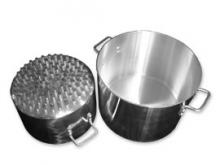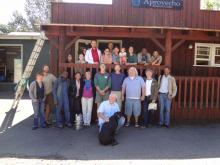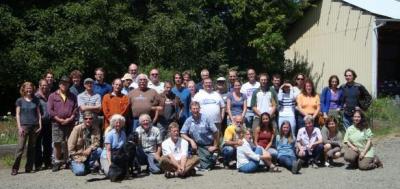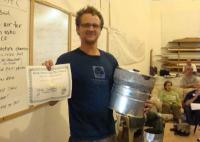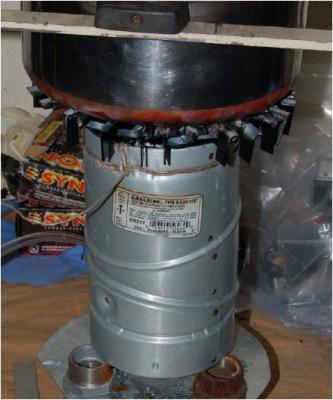Insights Into Fuel Efficiency and the Dissemination of Mud and Ceramic Stoves in Southern Africa
Peter Scott, Biomass Energy Consultant, December 23, 2007
 Lorena 2 Pot 2003
Lorena 2 Pot 2003
 Shielded One Pot 2003
Shielded One Pot 2003
Dear all
I wanted to offer a couple of brief insights into the recent dialogue regarding fuel efficiency and the dissemination of mud and ceramic stoves in southern Africa
First, A little back ground:
I worked with GTZ-EAP in Uganda for 3 weeks in August of 2003 . During that time I built a number of metal and brick stoves - both household and institutional - as well as bread ovens and a number of insulated ceramic combustion chambers . I didn't design the 2 pot Lorena stove but I did offer some suggestions on its design .
When I arrived GTZ had already begun developing prototypes for the two pot 'rocket ' Lorena mud stove as well as a single pot shielded mud stove. I made a number of recommendations: that they insulate the combustion chamber of the 2 pot stove and follow some simple rocket stove principles (shelf under fire, internal rocket elbow geometry, insulation, and proper gaps for optimal heat transfer).
2 pot Rocket Lorenas in Kampala
A number of tests of these stoves were performed by GTZ using the original WBT/PHU testing protocol (GTZ-EAP has the test data and the specific results so Im hoping that Leonard Magerwa might post the test data - Leonard are you out there?) during 2003
From my recollection the results looked something like this:
2 pot 'insulated' Rocket Lorena. Three versions were constructed and tested:
a.. -with pumice combustion chamber
b.. with 50/50 vermiculite c combustion chamber
c.. -with sawdust clay (unfired/non ceramic)
All of these stoves had very similar test results , something like slightly
above 30% PHU
2 pot mud rocket Lorena
a.. This stove performed slightly worse , something like 28% PHU
Single pot shielded fire mud stove
a.. This single pot stove had similar performance to the 'insulated' 2 pot stove. Around 30%. (sorry that's the best picture I have. Leonard , do you have a better one?)
Note: These 'lab' results are from the stove testing site that was set up in Kampala. They were built to exact specifications (stove built around 2 standardized pots and a 1 cm gap around both pots). As Dean and Tom pointed out, the stoves that were tested by USAID were most likely not constructed as per the original specifications nor were they used in the manner they were intended ( i.e. pots not submerged)
a.. The 'Insulated' versions all produced similar results in overall
efficiency even though they offer a spectrum of insulation quality : from
relatively high quality insulative materials such as pumice to a lower
quality insulative material such as unfired clay ceramic model .
a.. There was only a few percentage points of efficiency gained by
insulating the 2 pot stove
a.. Given the similarity of the results of the insulated stoves we could
conclude that in terms of fuel efficiency , the insulation of the
combustion chamber does not have a great impact on overall efficiency ie
reduction in fuel consumption. ( One would imagine that they had an improved
combustion efficiency, Unfortunately emission testing equipment was not
available during these tests but it did appear that the insulated stoves
were producing less visible smoke than the non insulated version)
a.. The un-insulated single pot chimneyless shielded fire proved to have
a similar efficiency as an insulated 2 pot chimney stove
Although these tests obviously aren't definitive they do point in a
certain direction which seem to support what Aprovecho has been saying for some time:
a.. Optimizing Heat transfer is important for reducing fuel consumption.
This means : using a skirt and/or tapering the slope underneath the pot so
that it reduces cross sectional area by .75 X
a.. Insulating the combustion chamber will have a greater impact on
improving combustion efficiency than it will on heat transfer and fuel
efficency
a.. With out standardization we can expect high performance or consistent
results
GTZ-EAP for a number of reasons - that they could elaborate upon - decided to promote the 2 pot Rocket Lorena ( my understanding is that the insulated version is promoted where possible, but due to poor access to materials,
it is the un-insulated version that is often produced in the field
When the stoves were designed it was recognized that they would face some significant dissemination challenges:
a.. Design drift. without proper tools and training the local producers
would not be able to produce the stove to the exact specifications of the
stove
a.. Material substitution. Many owners would not be able to afford the
metal chimney that was needed for optimal use of the stove. Instead local
producers often made shorter chimneys out of mud that were difficult or
impossible to clean and very slow to generate draft due to their higher
mass .
a.. User 'error' Users using different size pots and not submerging the
pot into the stove. This would obviously decrease heat transfer , increase
fuel consumption and lead to increased smoke in the kitchen ie not produce
similar tests results as those produced at the Kampala test site.
The 2 pot sunken pot Rocket stove has been a meaningful experiment ( I would like to acknowledge The staff at GTZ_EAP (Phillipe Simonis, John Kutesakwe and Leonard Magerwa ) have worked very hard to produce a large quantity of stoves in a relatively short time period ( 50,000+ in 3 years)
Way forward?
Any household stove project is going to be faced with many challenges. How do we bring fuel efficient stoves to the people who can least afford them but need them the most?. How do we bring standardized stoves , which require technical ability , accurate tools and perhaps even advanced materials to these users. Who is going to pay for them if the users cant? It seems that that CDM mechanisms and factory production are one option for delivering
stoves to the poorest.
Of course, one avenue that has not been fully explore din Africa is dissemination of the single sunken pot shielded fire mud stove. Given the results of the testing done in Kampala in 2003 , it seems that there is potential for this stove to save fuel . Of course there is still plenty of opportunity for that stove to be poorly built and used.. Although given that it doesn't require two pots for it to work , nor an expensive chimney there is the chance that it could fill a certain niche in the stove world.
I can envision multiple shielded fire stoves being constructed in and outside of the house . Each stove sized to a specific pot. Since the stoves would be very low cost , the users could build many stoves as needed.
Its is an exciting time in the household stove world. We still have not come up with a fuel efficient stove and dissemination strategy to bring stoves to poor households in Africa. Its going to take a lot of trial and error , and
fumbling around in the dark to work out how to do this.

